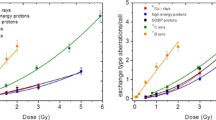Abstract
The structure and frequency of chromatid interchange types in C-metaphase cells of embryos of Schistocerca gregaria are described at the first mitosis following irradiation at the G 2 stage of interphase. The relationship between the different interchange types and the organisation of the interphase nucleus is discussed. It is concluded that most chromatid interchanges are induced between polarised chromosomes though the occurrence of loops and to a lesser extent of terminal overlapping may subsequently modify the appearance of these aberrations at metaphase.
Similar content being viewed by others
References
Carlson, J.G.: The effect of X-rays on grasshopper chromosomes. Cold Spr. Harb. Symp. quant. Biol. 9, 104–112 (1941).
Catcheside, D.G., and D.E. Lea: The effect of ionization distribution on chromosome breakage by X-rays. J. Genet. 45, 186–196 (1943).
— and J.M. Thoday: Types of chromosome structural change induced by the radiation of Tradescantia microspores. J. Genet. 47, 113–136 (1946).
Evans, H.J.: Chromatid aberrations induced by gamma radiation I. The structure and frequency of chromatid interchanges in diploid and tetraploid cells of Vicia faba. Genetics 46, 257–275 (1961); - Chromosome aberrations induced by ionizing radiations. Int. Rev. Cytol. 13, 221–321 (1962).
Fox, D.P.: The effect of X-rays on the chromosomes of locust embryos I. The early responses. Chromosoma (Berl.) 19, 300–316 (1966).
Garcia-Benitez, C., and S. Wolff: On the increase of sites for chromosome exchange formation after chromosome duplication. Science 135, 438–439 (1962).
Heddle, J.A.: Randomness in the formation of radiation-induced chromosome aberrations. Genetics 52, 1329–1334 (1965).
Holliday, R.: Radiation sensitive mutants of Ustilago maydis. Mutation Res. 2, 557–559 (1965).
Howard-Flanders, P., and R.P. Boyce: A biochemical pathway in the repair after UV-irradiation that may have steps in common with those of genetic recombination by breakage-reunion. Genetics 50, 256–257 (1964) (Abstract).
John, B., and B. Naylor: Anomalous chromosome behaviour in the germ line of Schistocerca gregaria. Heredity 16, 187–198 (1961).
Kitani, Y.: Orientation, arrangement and association of somatic chromosomes. Jap. J. Genet. 38, 244–256 (1963).
Lawley, P.D., and P. Brookes: Molecular mechanisms of the cytotoxic action of difunctional alkylating agents and of resistance to this action. Nature (Lond.) 206, 480–483 (1965).
Loveless, A., J. Cook, and P. Wheatley: Recovery from the ‘lethal’ effects of cross-linking alkylation. Nature (Lond.) 205, 980–983 (1965).
Moseley, B.E.B., and H. Laser: Similarity of repair of ionizing and ultraviolet radiation damage in Micrococcus radiodurans. Nature (Lond.) 206, 373–375 (1965a); - Repair of X-ray damage in Micrococcus radiodurans. Proc. roy. Soc. B 162, 210–222 (1965b).
Revell, S.H.: Chromosome breakage by X-rays and radiomimetic substances in Vicia. Heredity 6 (Suppl.), 107–124 (1953).
Riley, R., and T.E. Miller: The differential sensitivity of desynaptic and normal genotypes of barley to X-rays. Mutation Res. 3, 355–359 (1966).
Ris, H., and A.E. Mirsky: The state of the chromosomes in the interphase nucleus. J. gen. Physiol. 32, 489–502 (1949).
Savage, J. R. K.: The inverted cover-slip method for autoradiography. J. roy. micr. Soc. 80, 291–292 (1962).
Sax, K.: An analysis of X-ray induced chromosomal aberrations in Tradescantia. Genetics 25, 41–68 (1940).
—, and K. Mather: An X-ray analysis of progressive chromosome splitting. J. Genetics 37, 483–490 (1939).
Shaw, E.I.: A glutamic acid-glycine medium for prolonged maintenance of high mitotic activity in grasshopper neuroblasts. Exp. Cell Res., 11, 580–586 (1956).
Stevens, B.J.: The fine structure of the nucleolus during mitosis in the grasshopper neuroblast cell. J. Cell Biol. 24, 349–368 (1965).
Swanson, C.P.: The effects of ultraviolet and X-ray treatment on the pollen tube chromosomes of Tradescantia. Genetics 27, 491–503 (1942).
Taylor, J.H.: The replication and organisation of DNA in chromosomes. In: Molecular genetics, (ed. J.H. Taylor) part I. New York: Academic Press 1963.
Thoday, J.M.: Ph. D. thesis. Cambridge University 1948.
Walen, K.H.: Spatial relationships in the replication of chromosomal DNA. Genetics 51, 915–929 (1965).
Whitehouse, H. L. K.: Towards an understanding of the mechanism of heredity. London: Edward Arnold 1965.
Wilson, E.B.: The cell in development and heredity, 3rd ed. New York: Macmillan 1925.
Author information
Authors and Affiliations
Rights and permissions
About this article
Cite this article
Fox, D.P. The effects of X-rays on the chromosomes of locust embryos. Chromosoma 20, 173–194 (1966). https://doi.org/10.1007/BF00335206
Received:
Issue Date:
DOI: https://doi.org/10.1007/BF00335206




